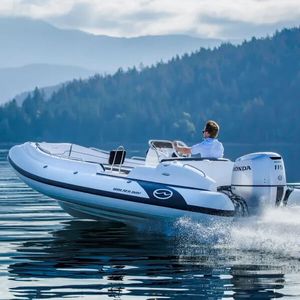2 Stroke Vs 4 Stroke Boat Motor Engine: What's The Difference
 Inflatable Sannapolis
30 Sep, 2025
14 mins read
19
Inflatable Sannapolis
30 Sep, 2025
14 mins read
19

Difference Between 2 Stroke and 4 Stroke Boat Engines
Choosing between a 2-stroke and 4-stroke outboard motor is one of the first decisions boat owners face. Both engine types have distinct advantages, and knowing the difference helps in deciding which suits your vessel and style of boating. Beyond performance, understanding how these engines work also makes it easier to care for them over the long term.
How a 2-Stroke Boat Engine Works?
A 2-stroke engine completes its power cycle in two movements of the piston, one up, one down. That means for every revolution of the crankshaft, the engine produces power. This design makes the engine lightweight and simple, with fewer moving parts than its 4-stroke counterpart.
Key benefits of 2-stroke engines:
- Lightweight and compact: Easier to transport and mount.
- Higher power-to-weight ratio: Delivers strong acceleration and performance for its size.
- Simple design: Generally easier to repair and less expensive upfront.
However, 2-stroke motors typically consume more fuel and require oil mixed with fuel for lubrication. They also tend to be louder and produce more emissions compared to modern 4-stroke engines. Brands like Yamaha and Tohatsu crafts the outboards with 2 stroke boat motor.
How a 4-Stroke Boat Engine Works?
A 4-stroke motor takes four movements of the piston, intake, compression, combustion, and exhaust, to complete a cycle. This means the engine fires once every two revolutions of the crankshaft.
Key benefits of 4-stroke engines:
- Fuel efficiency: Burns fuel more cleanly and economically.
- Quieter operation: Less vibration and noise on the water.
- Durability: Longer lifespan due to better lubrication.
- Environmental performance: Meets stricter emission standards.
The trade-off is that 4-stroke engines are usually heavier, more complex, and come with a higher upfront cost. Maintenance can also be more involved due to the number of moving parts.
Do checkout Mercury outboards to get 4 stroke boat motors.
Which Motor is Right for Your Inflatable Boat?
The decision often depends on your boating habits:
- For portability and quick power: A 2-stroke is often the preferred choice, especially for smaller boats or inflatables.
- For efficiency and longevity: A 4-stroke is ideal, particularly if fuel economy and smooth performance are priorities.
There is no one-size-fits-all answer. Some boaters even keep both types for different needs.
Shared Responsibility: Maintenance
While the two engines differ mechanically, they share one truth: neither will perform well without consistent care. Proper maintenance is what ensures reliability, whether it’s a 2-stroke powering a dinghy or a 4-stroke pushing a family cruiser.
- Fuel systems need attention to prevent clogs and build-up.
- Lubrication and oiling must be managed to reduce wear.
- Cooling systems require inspection so engines don’t overheat.
- Storage practices matter to avoid corrosion and long-term damage.
This last point, storage, is where many boat owners run into trouble. Engines left idle without preparation can develop problems that affect both performance and lifespan.
Why Winterization Matters
As boating season winds down, preparing your engine for storage becomes essential. Whether you own a 2-stroke or a 4-stroke, long periods of inactivity can cause issues like fuel degradation, corrosion, or internal wear. Winterization protects against these risks by stabilizing fuel, protecting internal parts with lubrication, and ensuring the motor is ready to start smoothly when the next season begins.
The process is more than a precaution; it’s an investment in preserving the engine’s health. Skipping it can mean costly repairs, while doing it right extends engine life, maintains efficiency, and helps avoid unpleasant surprises when it’s time to get back on the water. For a step-by-step breakdown, see this detailed guide on how to winterize an outboard boat motor.
Final Thoughts
The debate between 2-stroke and 4-stroke motors will continue as technology evolves, but both types share the same requirement: regular care. Choosing the engine that matches your boating style is only the first step. Protecting that investment through proper off-season storage is just as important.
By giving attention not only to performance but also to preparation, boaters ensure that their engines, whether 2-stroke or 4-stroke, are always ready for the water.
And to explore either of the motors don’t forget to visit Annapolisinflatables.net toady!
Choosing between a 2-stroke and 4-stroke outboard motor is one of the first decisions boat owners face. Both engine types have distinct advantages, and knowing the difference helps in deciding which suits your vessel and style of boating. Beyond performance, understanding how these engines work also makes it easier to care for them over the long term.
How a 2-Stroke Boat Engine Works?
A 2-stroke engine completes its power cycle in two movements of the piston, one up, one down. That means for every revolution of the crankshaft, the engine produces power. This design makes the engine lightweight and simple, with fewer moving parts than its 4-stroke counterpart.
Key benefits of 2-stroke engines:
- Lightweight and compact: Easier to transport and mount.
- Higher power-to-weight ratio: Delivers strong acceleration and performance for its size.
- Simple design: Generally easier to repair and less expensive upfront.
However, 2-stroke motors typically consume more fuel and require oil mixed with fuel for lubrication. They also tend to be louder and produce more emissions compared to modern 4-stroke engines. Brands like Yamaha and Tohatsu crafts the outboards with 2 stroke boat motor.
How a 4-Stroke Boat Engine Works?
A 4-stroke motor takes four movements of the piston, intake, compression, combustion, and exhaust, to complete a cycle. This means the engine fires once every two revolutions of the crankshaft.
Key benefits of 4-stroke engines:
- Fuel efficiency: Burns fuel more cleanly and economically.
- Quieter operation: Less vibration and noise on the water.
- Durability: Longer lifespan due to better lubrication.
- Environmental performance: Meets stricter emission standards.
The trade-off is that 4-stroke engines are usually heavier, more complex, and come with a higher upfront cost. Maintenance can also be more involved due to the number of moving parts.
Do checkout Mercury outboards to get 4 stroke boat motors.
Which Motor is Right for Your Inflatable Boat?
The decision often depends on your boating habits:
- For portability and quick power: A 2-stroke is often the preferred choice, especially for smaller boats or inflatables.
- For efficiency and longevity: A 4-stroke is ideal, particularly if fuel economy and smooth performance are priorities.
There is no one-size-fits-all answer. Some boaters even keep both types for different needs.
Shared Responsibility: Maintenance
While the two engines differ mechanically, they share one truth: neither will perform well without consistent care. Proper maintenance is what ensures reliability, whether it’s a 2-stroke powering a dinghy or a 4-stroke pushing a family cruiser.
- Fuel systems need attention to prevent clogs and build-up.
- Lubrication and oiling must be managed to reduce wear.
- Cooling systems require inspection so engines don’t overheat.
- Storage practices matter to avoid corrosion and long-term damage.
This last point, storage, is where many boat owners run into trouble. Engines left idle without preparation can develop problems that affect both performance and lifespan.
Why Winterization Matters
As boating season winds down, preparing your engine for storage becomes essential. Whether you own a 2-stroke or a 4-stroke, long periods of inactivity can cause issues like fuel degradation, corrosion, or internal wear. Winterization protects against these risks by stabilizing fuel, protecting internal parts with lubrication, and ensuring the motor is ready to start smoothly when the next season begins.
The process is more than a precaution; it’s an investment in preserving the engine’s health. Skipping it can mean costly repairs, while doing it right extends engine life, maintains efficiency, and helps avoid unpleasant surprises when it’s time to get back on the water. For a step-by-step breakdown, see this detailed guide on how to winterize an outboard boat motor.
Final Thoughts
The debate between 2-stroke and 4-stroke motors will continue as technology evolves, but both types share the same requirement: regular care. Choosing the engine that matches your boating style is only the first step. Protecting that investment through proper off-season storage is just as important.
By giving attention not only to performance but also to preparation, boaters ensure that their engines, whether 2-stroke or 4-stroke, are always ready for the water.
And to explore either of the motors don’t forget to visit Annapolisinflatables.net toady!
Written By:
Inflatable Sannapolis



Hotels at your convenience
Now choose your stay according to your preference. From finding a place for your dream destination or a mere weekend getaway to business accommodations or brief stay, we have got you covered. Explore hotels as per your mood.


